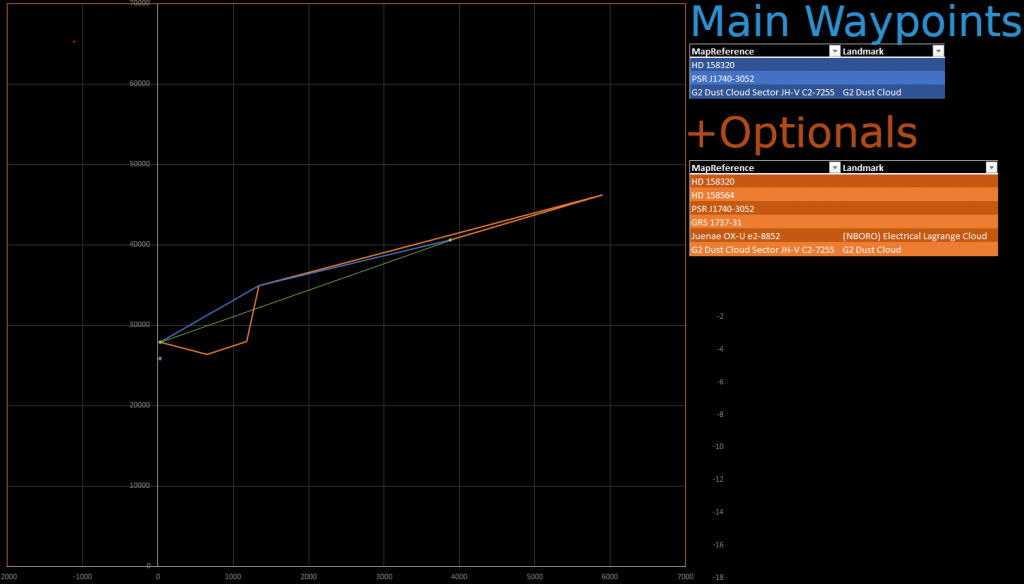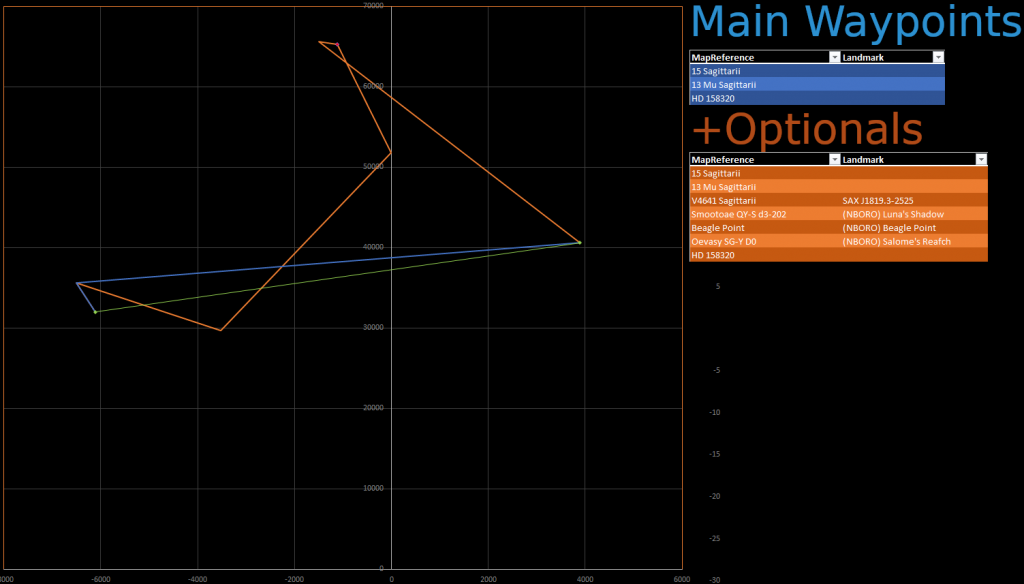With travelling out to the northernmost real star in the in-game galaxy out of the way, we begin our legs travelling back towards the bubble with the beginning of Leg 5! We will be travelling to the G2 Dust Cloud which is just north of the galactic center for this leg.
Dates
Start Date: August 21, 2021
End Date: September 4, 2021
Distances
Basecamp Line: 13,260.33 Ly
Main Waypoints: 13,358.72 Ly
Optional Waypoints: 29,167.13 Ly
Map, (click for full size):

Basecamp: G2 Dust Cloud Sector JH-V C2-7255
Main Waypoints
- Map References quick reference list, more details below
- PSR J1740-3052
- G2 Dust Cloud Sector JH-V C2-7255
Main Waypoints Details
- Map Reference: PSR J1740-3052
- PSR J1740-3052 is a young 570ms pulsar with an estimated age of only about 350 thousand years. It was originally though to have a companion star in a highly eccentric orbit with it with a mass greater than 11 times that of our sun. However later observations seem to discount that star being the companion star and instead a different star of much smaller radius and mass to be the actual companion star, and the other to just be nearby but not orbitally bound. – The star originally thought to be a companion but no longer thought to be would be 2MASS J17405002-3052039, which is not actually in the in-game universe.
- SIMBAD Link
- EDSM Link
- Map Reference: G2 Dust Cloud Sector JH-V C2-7255
- POI: G2 Dust Cloud
- The remnant of an event in 2013 of a gas cloud roughly three times the mass of earth passing within 36 lighthours (129,600 Ls) of Sagittarius A. It survived the encounter and has continued moving past Sagittarius A since 2013.
- SIMBAD Link
- EDSM Link
Optional Waypoints
- Map References quick reference list, more details below
- HD 158564
- PSR J1740-3052
- GRS 1737-31
- Juenae OX-U e2-8852
- G2 Dust Cloud Sector JH-V C2-7255
Optional Waypoints Details
- Map Reference: HD 158564
- This K class giant was just discovered in the in-game galaxy yesterday by “CMDR Orange!” and takes the mantle as the new furthest north known non-procedurally generated star in the in-game galaxy. — It was originally thought to be just 29,651.21 lightyears from earth based on parallax measurements conducted in 1997, however new measurements from 2007 have changed that estimate to be 46,594.76 lightyears.
- SIMBAD Link
- EDSM Link
- Map Reference: GRS 1737-31
- GRS 1737-31 is a stellar-mass black hole located in the Galactic Bar. This system was first observed in the year 1997 during observations of the galactic core, where it was detected as a source of gamma and X-rays. Today, three other stars have been found in the system; two of very hot O-class, and one hot B-class. The high mass and very similar young age of these objects suggests that they originate from a similar area. Orbital periods are also quite short, which appears to point towards either a shared origin or capture. No planets are present in this system.
- SIMBAD Link
- EDSM Link
- Map Reference: Juenae OX-U e2-8852
- POI: (NBORO) Electrical Lagrange Cloud
- This system has two points of interest. The first being the nebula in which it resides, named the Hengist Nebula by early explorers after Emperor Hengist Duval, and in the system there is a Notable Stellar Phenomena of an electrically active lagrange cloud

